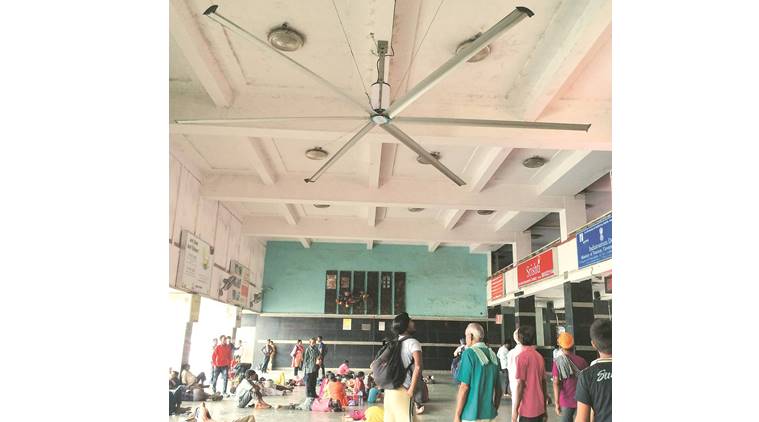___________________________________________________________________________________
__________________________________________________________________________________
The first time, Kumar (below) set the giant fan on full speed, and passengers’ luggage went flying; cleaning the fan is the most hectic part of the job, he says.
Taking A break from cleaning a train which has halted at Platform No. 1 of New Delhi Railway Station, 23-year-old Subhash Kumar walks up to the railing and takes a quick peek at the waiting hall outside. Relieved to see the recently installed jumbo fan running smoothly, he goes back to the train, while having a hearty conversation with his friend and younger colleague Vicky about his plans to take the same train sometime soon to his home in Munger in Bihar.
But these days, Kumar has little time for such conversations. Around two months ago, the 23-year-old, part of the 10-member contractual labour team behind cleaning efforts at Platform No. 1, was given the additional responsibility of operating the huge fan. “Things have gotten a little more hectic now,” he says.
It is 10.45 am on a Wednesday and the footfall at New Delhi Railway Station, one of the busiest in the country, has already crossed a lakh. However, instead of heading to their respective platforms, a large number of commuters are flocking to the waiting hall outside Platform No. 1. The draw is the fan: a six-winged device, with each wing 3.5 m long, installed around 45 days ago to provide passengers respite from the sapping August heat.
Manufactured by Pune-based company EcoAir, the fan has been installed at the station for a trial period of three months. It was put up after railway authorities in Delhi saw similar fans at the Mumbai Central Railway Station. The Railways, which plans to get more such fans for the New Delhi station in a month or two, will be shelling out an estimated Rs 6 lakh for each fan — Rs 4 lakh for the purchase and Rs 2 lakh for installation.
“The fan, which has a total diametre of 24 feet (about 7 m), runs on a 1.5 KW electric motor. Even its shiny red-knob regulator is much bigger than the average ones,” says EcoAir spokesperson Sandeep Jaisinghani. To rule out any chance of it falling on commuters, it has been fastened with thick ropes on all sides, adds Jaisinghani.
Leaning on an electric car — used to ferry physically-challenged passengers — stationed on the platform, Kumar recalls the buzz on the day the giant fan arrived. “All the staff members gathered to catch a glimpse of it, but they all left soon. Since I have always been fascinated with new technology, I stuck around,” says Kumar, who came to the Capital two years ago in search of a job. Little did he know that the railway station he arrived at would become his home away from home.
“Installing the fan was a tedious process spanning over six days…” he continues. “I learnt a lot about the technology used in the fan just by talking to the workers. I think I was given the responsibility of operating the fan because I seemed enthusiastic about it from the beginning. My bosses say my work pressure will increase once all the three fans are installed permanently,” he says.
But Kumar isn’t complaining too much. The slight change in job profile has made him happier and even rid him of his only grouse since arriving in Delhi — not being able to visit his home in Bihar.
Today as he operates the regulator of the jumbo fan, Kumar is reminded of another “hilarious” incident. “The first time I was operating the fan, I had no idea how it worked. I set the regulator on full speed, just like we do with smaller fans. Soon, all the bags and other luggage began flying in all directions. Even the passengers had to sit tight to keep themselves stable. Mein toh ghabra gaya tha (I got a little scared),” he laughs. “Now I only set the speed on one point (the lowest speed).”
On most days Kumar wakes up at 5.30 am, unlike his colleagues who have to wake up much earlier to get to work on time. “I stay at the station so I save on travel time,” he says.
After freshening up at the platform toilet, Kumar reports to work by 6 am, marking his attendance at the health inspector’s office on the first floor. “I haven’t missed a single day of work since I joined. It makes my friends angry though. They urge me to bunk work sometimes and head to the movies, just like they sometimes do,” he blurts out, only to hurriedly retract his comment, worried that his colleagues might run into trouble with the bosses.
“I love
Salman Khan. In Bihar I did not miss a single movie of his, but I haven’t seen any film since taking up this job. Sometimes during lunch break I watch movie trailers on YouTube on my friend’s smartphone,” he smiles. “The last film I watched was Kick. I wanted to do something as noble as Salman does in the film but soon I realised that I needed to save for my family first.”
Now, Kumar says, becoming the jumbo fan operator gives him a sense of being a “hero”.
He eagerly waits for the 10th of every month, when his thekedaar (contractor) hands him his salary: Rs 9,000, “not a penny less”. “I send some of it home. My mother says she feels proud that her son is earning so much in the big city,” he says with a big grin.
A railway official, however, hints Kumar’s fan job may not last too long. “We are trying to make the platform a smart one. Soon all electrical equipment will be managed with the push of a button from the control room. We have already started it on Platform No 8 and 9,” he says.
It is a little after 2 pm, and time for Kumar to head to the ‘multi-cuisine’ eating hall on the platform for lunch. Today it is his daily staple: a small serving of dal-chawal. On pay day, he opts for a “lavish lunch”.
Replenished, Kumar and his team — Vicky and Sunny, both residents of Azadpur, 13 km from the railway station — get down to their most hectic task: cleaning the giant fan. “We switch off the fan, place a ladder under it, and then begin cleaning the wings of the fan with a mop and soap water. It’s a tedious process but fun,” he says.
Around 5.30 pm, Kumar and his crew begin wrapping up for the day. He has two options now: either to have dinner at his friends’ home in Azadpur or find a spot on the platform and stare at the trains passing by, remembering his days in Bihar and all that he has left behind. On most days he settles for the latter.
“It is sort of ironical that I have been given charge of such a huge fan. Back in my village we still use hand-held fans,” he comments, now spreading a blanket on the platform, his bed for the night.
As for the fan, Kumar says it is switched off only when the officer who is in charge of the platform asks him to do so.
As he settles in, his thoughts wander to the giant fan again. “I have never seen anything like this before. Now that I have seen this fan, I feel like I have seen everything. I can die in peace,” he says, dozing off, oblivious to the loud sound of the trains passing by.
Source : The Indian Express , 28th Aug 2016






